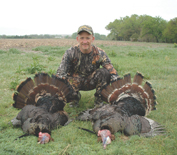 I want to chase Merriam’s out West, but I hear they’re different than Easterns. Is this true? — Bob Long, Grover, Pa.
I want to chase Merriam’s out West, but I hear they’re different than Easterns. Is this true? — Bob Long, Grover, Pa.
Funny you should ask. I just wrote an article on that subject for our sister publication Modern Hunter. Here’s the skinny. — Brian Lovett
It had been a long drive to South Dakota for my first Merriam’s hunt, and I was ready to plop my back against a tree and yelp up a gobbler. One problem: No trees.
Well, OK, there were a few trees. And yes, one of those trees held dozens of turkeys every night. But every morning at fly-down time, those birds would vacate the giant cottonwood and hit the prairie running, leaving me a half-mile behind them.
So began my introduction to Western turkeys.
If you’ve traveled from your comfortable Eastern woods across the Mississippi or Missouri rivers, you know what I’m talking about. Western turkey hunting is different.
It’s not that the birds are that foreign. Other than some light tail feathers and a funny-sounding gobble, they’re much like their Eastern cousins. They roost in trees, strut for hens, gobble at calling, loaf when it’s hot and will spook if you make a clumsy move. However, the country they inhabit is vastly different than your back 40 or the local wildlife area. Whether they’re Merriam’s on the South Dakota prairies, hybrids in Nebraska’s Sandhills or even hard-gobbling Rios on a vast Oklahoma or Texas cattle ranch, most Western turkeys have lots of open space to roam. And as any turkey hunter — East or West — knows, that’s an added challenge. How quickly you adapt can make or break your Western hunt.
The Scene
First, let’s diagnose the problem. Because many Western regions are tree-challenged, turkeys have fewer spots to roost. In fact, they’ll often roost on power lines in some areas of Texas. Because roost sites are at a premium, suitable trees are often jammed with birds every night. In fact, these “traditional roosts” can hold more than 100 turkeys.
However, these roosts are often not near prime feeding or nesting areas, so birds typically fly down and hit the open ground running. In some areas, they might cover several miles per day before returning to a roost at night. The result? Fly-down hunts near these big roosts are often a waste of time. Yes, it’s fun to hear 100-plus turkeys greet the dawn, but when the birds lace up their track shoes and depart, you’d better be ready to follow suit.
These mobile turkeys might go almost anywhere: river breaks, large pastures, mesquite flats, huge ag fields or similar areas. They’re often quite vocal, so you can usually keep track of them. However, that gobbling doesn’t mean they’re coming to you, and falling in behind a group of roving turkeys is an exercise in frustration.
The Cures
So, what does an Eastern turkey hunter do when confronted with Western turkeys? Simple. Go turkey hunting. Just be aware of and adapt to your surroundings. Try these tips.
1) Glass. Those binoculars that seem cumbersome in the pine woods of Alabama are critical out West. It’s unbelievable how easily a group of large black birds can disappear in a sea of grass or a rocky canyon. Glass open areas often and thoroughly. Scan closer areas first and farther spots afterward. Look for anything out of place. It’s better to take a second look at a distant cedar bush than to assume it’s not a turkey and bump a bird.
2) Be aggressive with repositioning on birds. Seems like stupid advice for wide-open country, but it’s very important. In fact, this is the biggest mistake Eastern turkey hunters make out West: They don’t move enough.
As mentioned, Western birds usually get on a traveling mission that can last all day. You must figure out where those turkeys are going and try to get ahead of them.
Use your binos to check for birds traveling down a draw or into a creek bottom. Then analyze the terrain, plan a hidden approach and execute it swiftly. Look for subtle features that might hide your approach, such as gulches, creeks, cedar groves on river breaks or even raised road beds. If you miss the birds, try to locate them again, and form another relocation plan.
Or, keep tabs on birds through aggressive calling, preferably with something loud and high-pitched to cut the wind, such as a box or aluminum call. Listen to gobbling to discern the travel path of a longbeard, and again, look at the terrain, plan an end-around and get moving. If you’re one draw away from where the birds went, keep contact with them via calling, and keep moving until you’re in the right spot.
Another repositioning trick is a favorite of turkey hunters everywhere: crawling. OK, call it low-level relocation if you want, but it’s crawling. You’re a predator. Don’t be ashamed of a good ambush.
Sometimes, grass, brush, mesquite or other low cover might let you belly-crawl to a better position or even within shooting distance of Western turkeys. Don’t be proud. Get after it. The first South Dakota Merriam’s I shot was 300 yards across a wide-open CRP field when we saw it initially. A buddy and I crawled 200 yards to a fence line and then soft-yelped at the bird. Within seconds, an entire flock was 25 steps away, and the gobbler was flopping. And hey, we still called him in.
3) Turn the tables. Yeah, wide-open turkeys can see you. Why not use that to your advantage? Break out a realistic hen decoy, and move it back and forth above the grass. Have a buddy back it up with some yelping. Or take a gobbler or jake fan, hold it high, and spread it in plain sight of an ol’ longbeard. His machismo might get the best of him and prompt him to run in for a rumble. The only fight he’ll get is with 2 ounces of shot in his noggin.
Above All
If you do nothing else on a Western turkey hunt, don’t be shy. You can certainly kill birds by waiting at likely areas and yelping, just like you would in the woods of Pennsylvania or Missouri. But it’s usually better to locate birds and move aggressively on them, trying to get where they want to be. Will you bump turkeys doing this? Sure. But that’s the great thing about being out West: There are tons of turkeys and little hunting pressure. If you booger a breeding flock, laugh it off, switch spots, find some more birds and get after them.
Before you know it, you’ll be spreading the white or buff-colored tips of a Western turkey tail fan.
